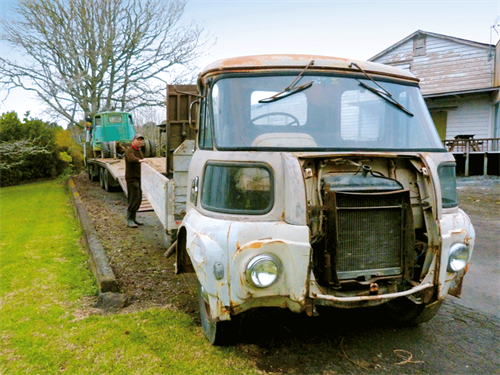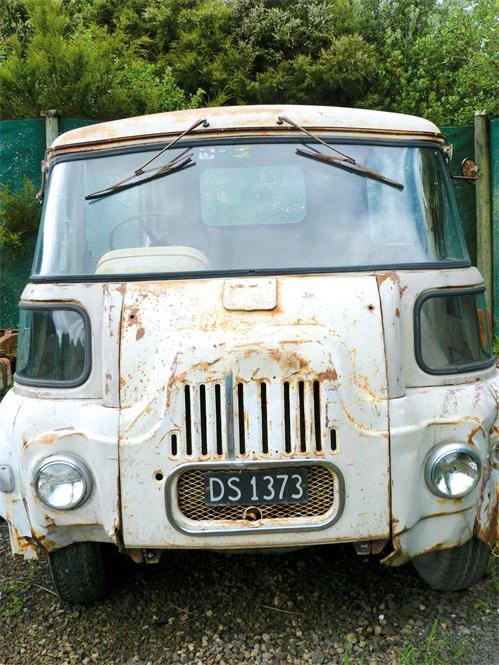Restoration project: FGK Morris restoration part 1









|

|

|

|
Lyndsay Whittle begins his new project; this time, it is the FGK Morris
After wrapping up the restoration of the FH140 Mitsubishi, Lyndsay Whittle begins his new project; this time, it is the FGK Morris
If there is any truth in the old saying about there being no rest for the wicked, then I must have been bad in a previous life (if not this one), as I had hoped to have a wee break between finishing restoration #3, the FH140 Mitsubishi, and starting on the current job.
If I am entirely truthful about the situation, there has been a little bit of work going on in the background to get this project under way, the reason being that I have needed to keep myself busy during some downtime when I was unable to progress with the Mitsi job due to reasons such as bad weather.
But first, to back up the bus (or the truck in this case), I will give you a little background on what we are doing here and also a heads-up on the idiosyncratic reasons behind the fact that I will be spending a year or so of my time breathing new life into a strange-looking old commercial vehicle.

To read the full story of how I collected the truck from Albury, south of Ashburton a year or more ago, you would need to go back and read issues 255, 256, and 257 from late 2014. But the short version is that I saw one of these trucks in an episode of the Heartbeat series on TV, where service station proprietor Bernie Scripps had one of these weird trucks as a tow wagon.
I had also done an article for this magazine a few years ago titled ‘Morris and Paeroa’, which featured a 1967 model that the Ed and I saw for sale on the roadside during a road trip.
From memory, the truck was for sale for approximately $8k at the time, and looking back, it would have been a hell of a lot less costly way of owning one than the road I am currently going down.
However, on the other side of that coin is the fact that readers are going to get a few laughs at my expense, as I recount the comings and goings over the next few months.
I have found that each of the three previous restorations I have carried out—the K Bedford, the International fire truck, and the FH140 Mitsubishi—have all required completely different approaches to tackle the restoration. However, for this issue, I would like to focus on the major differences between restoration number 1 (K Bedford), which got me hooked to restoring trucks, and the current job at hand.
It seems that the only similarity between the two trucks is that they are both old and are both manufactured in England. Beyond that, it appears that ne’er the twain shall meet.
Although I know this restoration is going to be a big one, the part of the process that will prove to be the most difficult will be getting this beast through the VIN process.

I had proof of ownership for nearly 40 years for ‘Beddy’ and used to, at one stage, use it commercially. On the other hand, I know precious little about the Morris’ previous life other than the fact that it was a milkman’s truck in Kurunui near Winchester in Canterbury.
All I have to go on with the current truck is a receipt of purchase from the guy I bought it from in Albury near Winchester, stating that I was purchasing two trucks—one FGK30 (registration plate DS1373) Morris and a larger Austin FGK60 truck (registration plate DV8430) for $705.
The trucks were advertised as being "two for the price of one", but in reality, they are two entirely different species, despite the fact that the cabs are essentially the same aside from having different radiator grills and different-sized engine cowlings to accommodate the six-cylinder engine in the larger three-tonne FGK60.
Time to make a decision
Back in 2014 when I unloaded the two trucks from the transporter after their long trip up from the South Island, I was still carrying out the restoration on the Bedford—a job I didn’t want to lose focus on. So there was little else for me to do but park the vehicles up and wait for a slot of free time to get my head around which one I would end up restoring.
One part of me wanted to concentrate my efforts on the larger of the two trucks, as it had the six-cylinder engine and was a larger truck than the K Bedford I was then working on.
However, the little FGK 30 was in much better condition and would be a far easier restoration project.
So I decided to ‘park’ any decision-making until I got the Bedford job out of my hair (what
there is left of that) and could give the whole decision-making process the attention it deserved.At this stage in the proceedings, I had calculated that the Beddy job had a year at the very least to run, as by then, we were only at the stage of painting the cab and mudguards prior to assembling the components.
After that was completed, we still had glass, upholstery, and wiring to fit, not to mention building the deck, and of course, facing the dreaded VIN process.Needless to say, I wasn’t in too much of a mood to pay attention to the Morris and the Austin, given that I was currently throwing all my spare time at the K Bedford restoration with a little bit more thrown in for good measure.

Ironically, when I checked the timeline of the Bedford’s restoration, I found that all that work I have just mentioned that was required to complete the restoration, in fact, didn’t take a year at all. Incredibly, it only took five months. I had figured that getting the K Bedford back on the road wouldn’t be easy, having had experience with bureaucracy over the years, but somehow everything fell into place with incredible ease. I am not expecting the same luck with the Morris.
One thing is for certain is that I am going to enjoy sharing the successes and the pitfalls that we encounter along the way, and I will finish off part one with a traditional restoration tip of the month, which has been borrowed from a road sign you see about the country—Expect the unexpected.
Keep up to date in the industry by signing up to Deals on Wheels' free newsletter or liking us on Facebook.





.jpg)


.jpg)







